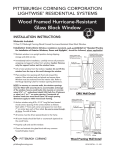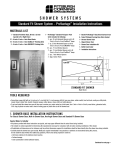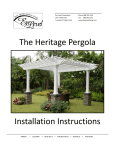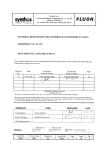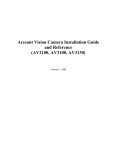Download Pittsburgh Corning 120415 Instructions / Assembly
Transcript
Se inclu yen las instr uccione s en espa ñol Mortar Glass Block Installation System assembly instructions pittsburghcorning.com Pittsburgh Corning Mortar Glass Block Installation System Assembly Instructions Introduction: The Mortar I System utilizes Pittsburgh Corning perimeter channels on all four sides. You will also use Universal Mortar Spacers and glass block mortar to produce clean, consistent 1/4" joints and a traditional grid look. The Mortar II System does not use the Pittsburgh Corning perimeter channels but instead utilizes expansion strips, panel reinforcing and panel anchors. You will also use Universal Mortar Spacers and glass block mortar to produce clean, consistent 1/4" joints and a traditional grid look. Here is additional information about each method. Mortar I: (page 3) • This method is designed for use with Pittsburgh Corning Premiere (4" thick) and Thinline ® (3" thick) Series Glass Block. • The installation recommendations are for small residential panels of 25 sq. ft. or less. • Not for use in constructing curved glass block walls. • Interior and exterior panels must be framed on all four sides. Note: This instruction is not to be used in constructing curved glass block applications. All glass block panels are non-load bearing, so adequate provisions must be made for support of construction around the panel. Mortar II: (page 14) • This method is designed for use with Pittsburgh Corning Premiere (4" thick) and Thinline ® (3" thick) Series Glass Block. • The installation recommendations are for interior or exterior residential panels larger than 25 sq. ft. • This method may be used to install projects framed on two, three, or four sides. • Premiere Series - Panel size limitations - Interior (250 sq. ft. max) and *Exterior (144 sq. ft. max.). • Thinline ® Series - Panel size limitations - Interior (150 sq. ft. max.) and *Exterior (85 sq. ft. max.). * Exterior panel size limitations are based on a 20 PSF. For higher windloads consult local building codes or call Pittsburgh Corning Corporation at 1-800-624-2120. 1 Note: All glass block panels are non-load bearing, so adequate provisions must be made for support of construction around the panel. The joints of the Mortar I and Mortar II Systems utilize a traditional installation method using a mortar finish for the classic “grid” look. Glass block sealant should be used to seal the perimeter on both sides of the panel. Before you begin installing your glass blocks, decide which installation method is right for your project. The materials required for Mortar System glass block installation are: 1. Pittsburgh Corning Premiere Series or Thinline ® Series Glass Block 2. Universal Mortar Spacers 3. Perimeter Channels - Premiere (4") or Thinline ® (3") (Mortar I System) 4. Expansion Strips 5. #6 x 1" zinc-plated flat head screws (approx. three per lineal foot of perimeter channel) (Mortar I System) 6. Panel reinforcing (Mortar II System) 7. Panel anchors (Mortar II System) 8. #12 x 1" zinc-plated pan head screws (Mortar II System) 9. Glass Block white premixed mortar 10.Pittsburgh Corning Glass Block Sealant 11.White touch up paint (Mortar I System) 12.Latex paint, Weldbond® adhesive, or asphalt emulsion depending upon application. 2 This is a reference guide for where “REGULAR” and modified spacers are used. = “REGULAR” Spacer = “FLAT” Spacer = “H” Spacer 4. Mortar Preparation The following gives an idea of the number of blocks that can be installed per 50 pound bag of mortar. White Premixed Glass Block Mortar Number of blocks per 50 lb. bag of mortar Block Sizes (Nominal) 4" x 8" 6" x 6" 6" x 8" 8" x 8" 12" x 12" No. of Premiere Series (4" thick) 34 34 30 26 18 No. of Thinline® Series (3" thick) 42 42 36 32 N/A Based on 1/4" mortar joints A. Mix mortar according to the instructions on the premix mortar bag. When mixed to the proper consistency, mortar should stick to the edge of the glass block when turned on edge. Be sure to read and understand all precautions outlined by the mortar manufacturer. Freshly mixed mortar may cause skin irritation. Note: Slowly add water to mortar mix. DO NOT mix more mortar than you can install in one hour. Note: Avoid direct contact when possible and wash exposed skin areas promptly with water. If any gets into eyes, rinse immediately with water and seek prompt medical attention. 7 D. Use a soft, dry cloth to remove the excess film. A common household plastic scouring pad can also be used. E. Cut the expansion strip to a 1-1/2" width and insert it between the top of the blocks and the frame. 7F TOP HALF CHANNEL 7E 7G F. Apply sealant to the back of the half-section of channel and install it between the expansion strip and frame. G. Apply glass block sealant around the perimeter to seal the glass block and channel. Also seal the top channel to the frame at the head. Note: For exterior panels or wet areas, also seal where the channels meet the framing. 13 D. Bend each panel anchor 90° to produce a short arm (approximately 4"). 90° 4” 2D E X P A N S I O N 2E E. With scissors or utility knife, trim the expansion strip for length based on the distance between anchors. Trim the expansion strip width to 2-1/8" for Thinline® Series block and 2-7/8" width for Premiere Series block. S T R I P 3. Mortar Preparation This chart will give you an idea of the number of blocks that can be installed per 50 pound bag of mortar. White Premixed Glass Block Mortar Number of blocks per 50 lb. bag of mortar Block Sizes (Nominal) 4" x 8" 6" x 6" 6" x 8" 8" x 8" 12" x 12" No. of Premiere Series (4" thick) 34 34 30 26 18 No. of Thinline® Series (3" thick) 42 42 36 32 N/A Based on 1/4" mortar joints A. Mix mortar according to the instructions on the premix mortar bag. When mixed to the proper consistency, mortar should stick to the edge of the glass block when turned on edge. Be sure to read and understand all precautions outlined by the mortar manufacturer. Freshly mixed mortar may cause skin irritation. Note: Slowly add water to mortar mix. DO NOT mix more mortar than you can install in one hour. Note: Avoid direct contact when possible and wash exposed shin areas promptly with water. If any gets into eyes, rinse immediately with water and seek prompt medical attention. 18 S. Install a vertical panel anchor after the second block and screw the short leg of the anchor to the curb. All panel 4S anchors should be attached using #12 x 1" zinc-plated head screws. Use two screws per anchor. Note: If attaching the panel anchors to tile or masonry, plastic screw anchors should be used. T. Apply mortar so that the long leg of the anchor is embedded in the vertical joint. 4T U. Follow this procedure for the rest of the blocks in the first row, installing a panel anchor after every 2 blocks. V. Check periodically to ensure that the glass blocks are straight, level and plumb. Note: If you find a problem, adjust the block into place with a rubber mallet before proceeding. W. Using a polyfoam brush, remove excess mortar and fill any voids on both sides of your panel. 4W 22 E. Remove the previously installed “T” spacers at both jambs at the top of the second row and apply a 3/8" to 1/2" ve mortar bed on top of mocers e R pa bs this row. s m a “T” oth j b at 5E F. Install panel anchors at both jambs by completely embedding them in the mortar and fastening them to the jamb. 5F G. Reinsert the “T” spacers you previously removed. Note: Additional mortar may need to be applied to cover the anchor. 24 M. Screw the short leg of the anchor to the top of the opening. 5M B. With moderate pressure, run the striking tool over all the joints. It is best to strike all the horizontal joints first, then the vertical joints so that the pattern is uniform. Fill any voids with mortar. Note: Striking removes excess mortar and compacts it to create a smooth, concave, moisture-proof seal. N. Continue this two block procedure across the final row. After installing the final block, be sure to press back into the joints any mortar that has been forced out. O. Install the expansion strip across the head. Note: Because the top course meets the expansion strip at the head, no mortar is placed at the top edge of these blocks. EXPANSION STRIPS 5O 6B C. After striking, use a damp sponge to remove the excess mortar from the block face, rinsing the sponge frequently. Do not be concerned about the dry film that remains on the blocks, it will be cleaned off later. Note: Allow the mortar to dry for about two to three hours before proceeding. D. Use a soft, dry cloth to remove the excess film. A common household plastic scouring pad can also be used. E. Apply sealant around the perimeter of the panel on both sides. Note: Where curb was used, you’ll want to cover it with trim molding. You may also use moldings at the jambs and head. 6. Finishing Note: Allow the mortar to set up for about one hour before proceeding. 6E Note: To prevent scratching of the glass DO NOT use abrasive materials for this cleanup. A. Twist off the spacer tabs on both sides of the panel. 27 F. If your glass block panel will function as a shower wall, after about a week, coat the mortar joints on both sides of the panel with tile grout sealer for mold and mildew protection. 28 Maintenance An important part of the functional beauty of Pittsburgh Corning Glass Block products is that they are virtually maintenance free! There’s nothing to rot, rust, peel or paint. All that is needed is an occasional wiping with a damp, soft cloth on interior panels or a hosing on exterior panels, With minimal attention, your Pittsburgh Corning Glass Block will remain sparkling and beautiful for years! If you need assistance We hope these instructions are clear and answer your questions about the installation of Pittsburgh Corning Premiere Series Glass Blocks and Finishing Units with the ProVantage ® Glass Block Installation System. For additional information on Pittsburgh Corning Glass Block visit our website at pittsburghcorning.com or call 1-800-624-2120. 29 The information contained herein is accurate and reliable to the best of our knowledge. But, because Pittsburgh Corning has no control over installation, workmanship, accessory materials, or conditions of application NO REPRESENTATION OR WARRANTY, EXPRESSED OR IMPLIED, EITHER AS TO MERCHANTABILITY OR FITNESS FOR A PARTICULAR PURPOSE, IS MADE as to the performance or results of an installation containing the products which extends beyond the description on the face hereof and ANY AND ALL LIABILITY FOR NEGLIGENCE, STRICT LIABILITY OR ANY OTHER THEORY OF TORT LIABILITY IS EXPRESSLY DISCLAIMED. If the products otherwise fail to conform to the representations made herein, through no fault of the buyer, buyer’s exclusive remedy at Pittsburgh Corning’s option, is the repair or replacement, of the nonconforming products or return of the purchase price paid by purchaser. If replacement is elected, Pittsburgh Corning will not be responsible for installation or labor costs. In no event shall Pittsburgh Corning be responsible or liable for any incidental, special, consequential or punitive damages which might result from product failure, regardless of the theory of liability upon which any such damages are claimed. Pittsburgh Corning Corporation provides written warranties for many of its products, and such warranties take precedence over the statements contained herein. You may obtain a copy of the warranty for this product by contacting Pittsburgh Corning. 30 Pittsburgh Corning Corporation 800 Presque Isle Drive Pittsburgh, PA 15239-2724 1-800-624-2120 pittsburghcorning.com Weldbond ® is a registered trademark of F. T. Ross Ltd. All other trademarks and registered trademarks in this brochure are owned and protected by Pittsburgh Corning Corporation, Pittsburgh, PA 15239-2724. © 2011 Pittsburgh Corning Corporation Printed in U.S.A. GB-243 50M Rev. 11/11 (Replaces Rev. 5/07)




















